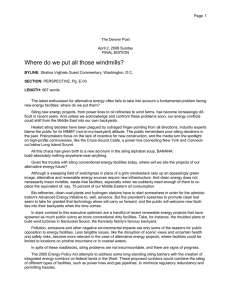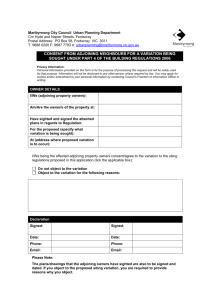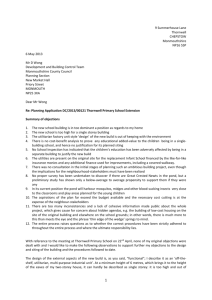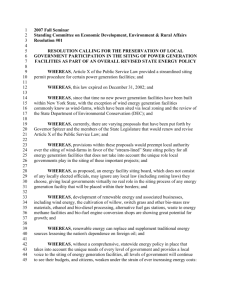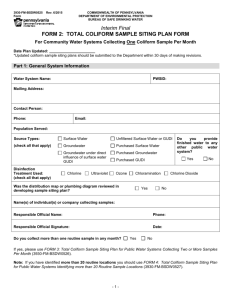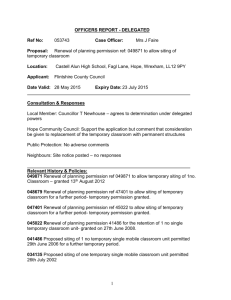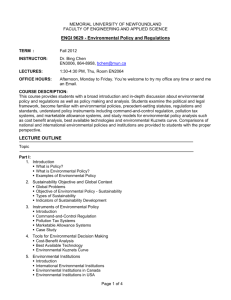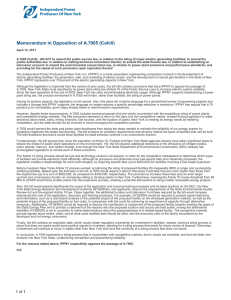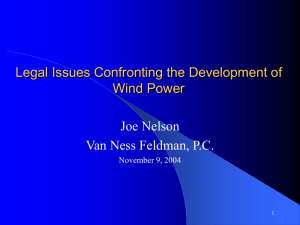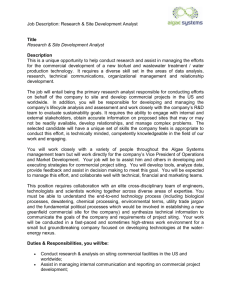Table 1 Criteria
advertisement
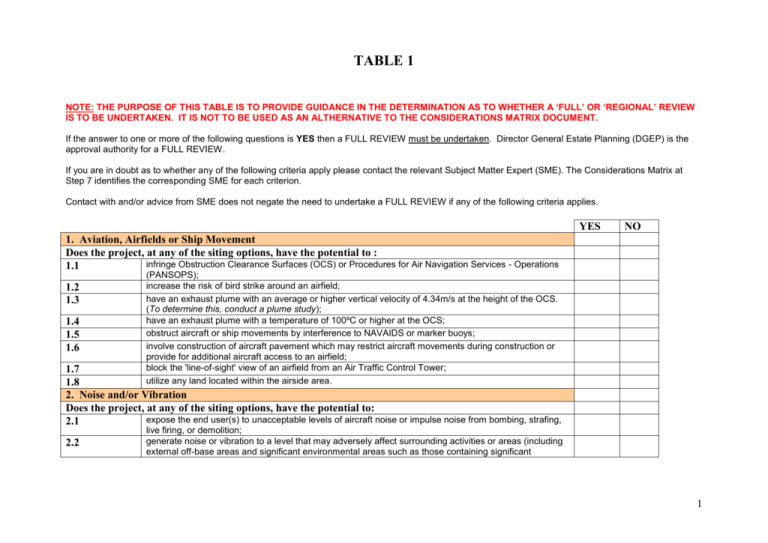
TABLE 1 NOTE: THE PURPOSE OF THIS TABLE IS TO PROVIDE GUIDANCE IN THE DETERMINATION AS TO WHETHER A ‘FULL’ OR ‘REGIONAL’ REVIEW IS TO BE UNDERTAKEN. IT IS NOT TO BE USED AS AN ALTHERNATIVE TO THE CONSIDERATIONS MATRIX DOCUMENT. If the answer to one or more of the following questions is YES then a FULL REVIEW must be undertaken. Director General Estate Planning (DGEP) is the approval authority for a FULL REVIEW. If you are in doubt as to whether any of the following criteria apply please contact the relevant Subject Matter Expert (SME). The Considerations Matrix at Step 7 identifies the corresponding SME for each criterion. Contact with and/or advice from SME does not negate the need to undertake a FULL REVIEW if any of the following criteria applies. YES NO 1. Aviation, Airfields or Ship Movement Does the project, at any of the siting options, have the potential to : infringe Obstruction Clearance Surfaces (OCS) or Procedures for Air Navigation Services - Operations 1.1 1.2 1.3 1.4 1.5 1.6 (PANSOPS); increase the risk of bird strike around an airfield; have an exhaust plume with an average or higher vertical velocity of 4.34m/s at the height of the OCS. (To determine this, conduct a plume study); have an exhaust plume with a temperature of 100ºC or higher at the OCS; obstruct aircraft or ship movements by interference to NAVAIDS or marker buoys; involve construction of aircraft pavement which may restrict aircraft movements during construction or provide for additional aircraft access to an airfield; block the 'line-of-sight' view of an airfield from an Air Traffic Control Tower; utilize any land located within the airside area. 1.7 1.8 2. Noise and/or Vibration Does the project, at any of the siting options, have the potential to: expose the end user(s) to unacceptable levels of aircraft noise or impulse noise from bombing, strafing, 2.1 2.2 live firing, or demolition; generate noise or vibration to a level that may adversely affect surrounding activities or areas (including external off-base areas and significant environmental areas such as those containing significant 1 2.3 ecological values or Indigenous sacred sites); generate noise or vibration to a level that may adversely affect the Work Health & Safety of the occupants of adjoining working areas. 3. Building Does the project, at any of the siting options, have the potential to: require a minimum separation distance from existing Electromagnetic Radiation Emitting devices (E.g. a 3.1 3.2 3.3 3.4 3.5 new fuel farm in proximity to a NAVAID, radar or transmission Antenna); render existing electrical infrastructure inadequate or have a substantial impact on an electrical reticulation system; require separation distance from existing facilities or infrastructure for safety reasons (E.g. projects involving the handling or storage of Explosive Ordnance, Fuel or other dangerous or hazardous items / materials); affect a Central Emergency Power Station (CEPS) or Intake Substation (ISS); fail to meet the Defence Manual of Fire Protection & Engineering's (DMFPE) separation distances between buildings or protected works. 4. Safety Does the project, at any of the siting options, have the potential to: encroach upon an Explosive Ordnance Safety Template or Forward Firing Template; 4.1 involve the handling or storage of explosive ordnance; 4.2 adversely affect the safe handling or storage of existing explosive ordnance; 4.3 render existing fire fighting and water supply (FFWS) inadequate; 4.4 be a location where fire brigade response is unavailable or inadequate (e.g. part time volunteer fire 4.5 4.6 brigade);. Adversely affect the WH&S of occupants of adjoining working areas or adjoining land holders. 5. Environment & Heritage Does the project , at any of the siting options, have the potential to: be located within an area of significant environmental value as identified in a Defence Environmental 5.1 5.2 5.3 Management Plan or a Zone/Master Plan; require a substantial removal (clearing) of native vegetation with significant ecological value; be sited within an area that is considered to be prone to bushfire unless the structure is a Class(10(a) building (shed, carport garage, etc.) under the Building Code of Australia and is not to be used for the 2 5.4 5.5 5.6 storage of explosive, hazardous or flammable material; involve significant alterations or additions, or complete demolition of a building or structure with potential heritage value; be located within a known heritage precinct as identified in a Defence Heritage Management Plan or listed on a Commonwealth Heritage Register; involve the disposal of contaminated materials, soils etc e.g. asbestos, hydrocarbons, PCB's. 6. Zone or Master Plan Do all the siting options comply with the Zone or Master Plan siting guidance? Zone or Master Plans provide guidance as to what type of land uses are suitable to locate within 6.1 nominated zones or areas of a base. Are any of the siting options located within a zone, precinct or area in the base Zone or Master Plan which is not identified as being suitable for the type of land use being proposed? 7. Contamination Do any of the siting options have the potential to be contaminated by; previous uses of the site, such as fuel depots, chemical storage, land filling or similar; 7.1 demolition of buildings which may have contained asbestos on that land. 7.2 8. Traffic and vehicle movements Do any of the siting options have the potential to: significantly increase the number of vehicle movements on internal or external road networks, 8.1 including increasing the number of vehicles entering and exiting the base; change the type and size of vehicles using internal or external road networks, such as the 8.2 introduction of B-Doubles or triple vehicles and other heavy military transport vehicles. 3
